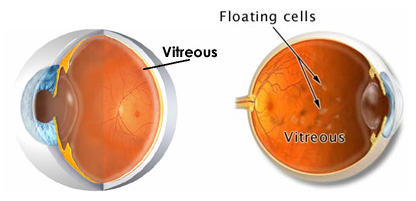Flashing Lights and Floaters
Many people develop floaters and flashing lights but, occasionally, they can be signs of tears or retinal detachments which are serious problems that can cause vision loss.
The inside of the eye is like the inside of a room. The back wall of the eye is lined by nerve tissue called the retina. The center of the retina is the macula where we see the best.
In the middle of the eye is a gel called the vitreous gel. Over time, that gel will change and part of it forms a liquid and part of it forms clumps. We see these clumps of gel as floaters in our vision. The gel is also attached to the retina at the back of the eye. As the gel moves, it can pull on the retina sometimes causing flashes of light.

Usually the gel separates cleanly and the flashes of light improve over a period of few months. Sometimes the gel can pull hard enough to tear piece of retina. If this happens, it is possible for fluid to go underneath the retina and detach the retina like peeling wallpaper off a wall. This is a retinal detachment and will cause vision loss.
If you develop new floaters, new flashing lights or a shadow blocking the peripheral vision, it is very important to let your ophthalmologist know promptly so that your eye can be examined carefully. If a retinal tear is found, this can be treated with laser treatment to reduce the risk of a retinal detachment and vision loss. If you have a retinal detachment, then you will require surgery.
For most people, the floaters and flashing lights will improve over a period of a few months as the floaters settle with gravity and drift out of the center of your vision. Please remember that if you develop anything new; new floaters, new flashes or a shadow blocking the peripheral vision, it is important to call your ophthalmologist promptly.
FIND OUT MORE BY WATCHING THE INFORMATIONAL VIDEO (BELOW)
